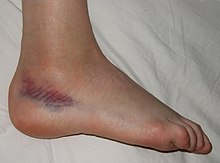sprain
| Classification according to ICD-10 | |
|---|---|
| S00 - T14 | Sprain (by body region) |
| ICD-10 online (WHO version 2019) | |
A sprain or distortion (lat. Twist ) is an injury to a ligament or a joint capsule in which the collagen fibers of these structures are severely overstretched.
Affected areas are usually the wrist , foot or knee , most often a sprain occurs after violent overstretching of the ankle (as a supination trauma ). The cervical spine (cervical spine) can also be affected by a sprain if the head is jerked forwards or backwards as a result of a car accident. Such injuries are referred to as whiplash or cervical spine distortion.
Swelling, often with a bruise , is the result of a sprain. A ligament strain can be very painful. Indications of a sprain can therefore be pain (especially with appropriate movement), swelling and / or a blue discoloration, which often results from a bruise. If the ligament is torn , there is sudden, sharp pain; A capsule tear usually leads to a stabbing pain, which then turns into a pulsating pain.
Treatment is given as first aid
- Cooling (anti-inflammatory, analgesic),
- Resting (reducing irritation) and
- Elevation (decongestant effect)
of the joint. A compression bandage can also be applied (see PECH rule ).
The HARM rule dictates avoiding anything that could increase bleeding or swelling for the first 72 hours after the injury. You should therefore avoid heat (e.g. baths, saunas, hot water bottles), alcohol, excessive exercise and massages. The four letters stand for the English words heat, alcohol, running, massage .
It must be checked whether the ligaments have been damaged in their continuity.
The outer ligaments of the foot are most often torn . However, only an estimated 50% of patients with acute ligament injuries seek medical help and are therefore adequately treated.
Even lighter ligament injuries often lead to chronic joint instability , with a number of injuries then coming together over the years to form a pronounced throat joint. This often leads to post-traumatic osteoarthritis at a young age , mostly in people who are physically active. Orthopedists recommend that you see a trauma surgeon or orthopedic surgeon more often than you think necessary. A non-medical professional is hardly able to differentiate between minor and major injuries.
Web links
Individual evidence
- ↑ WONCA International Classification Committee, T. Mally, H. Tönies and K. Zehnder International Classification of primary care ICPC-2, Springer Verlag, 2000, pp 103 Online
- ↑ Distorsion (sprain): Overstretching of the joint at onmeda.de, accessed on May 15, 2016.
- ↑ How is a sprained ankle treated? from Gesundheitsinformation.de, accessed on November 18, 2018.
- ↑ Jacqueline Payne: Ankle Injury. Sprained or Broken Ankle. March 1, 2018, accessed November 17, 2016 . Certified by The Information Standard of the National Health Service.
- ↑ Safety Guidelines for Children and Young People in Sport and Recreation. Sports Medicine Australia, March 1, 2018, accessed November 17, 2016 . P. 13.
- ↑ Fresh outer ligament rupture on the upper ankle. In: guidelines for trauma surgery - newly developed guideline AWMF no. 012-022, ICD S-93.40, S-93.41, S-93.42, S-93.43. Last processing date: August 8, 2017, valid until August 8, 2022. German Society for Orthopedics and Trauma Surgery (DGOU), accessed on October 14, 2018 .
